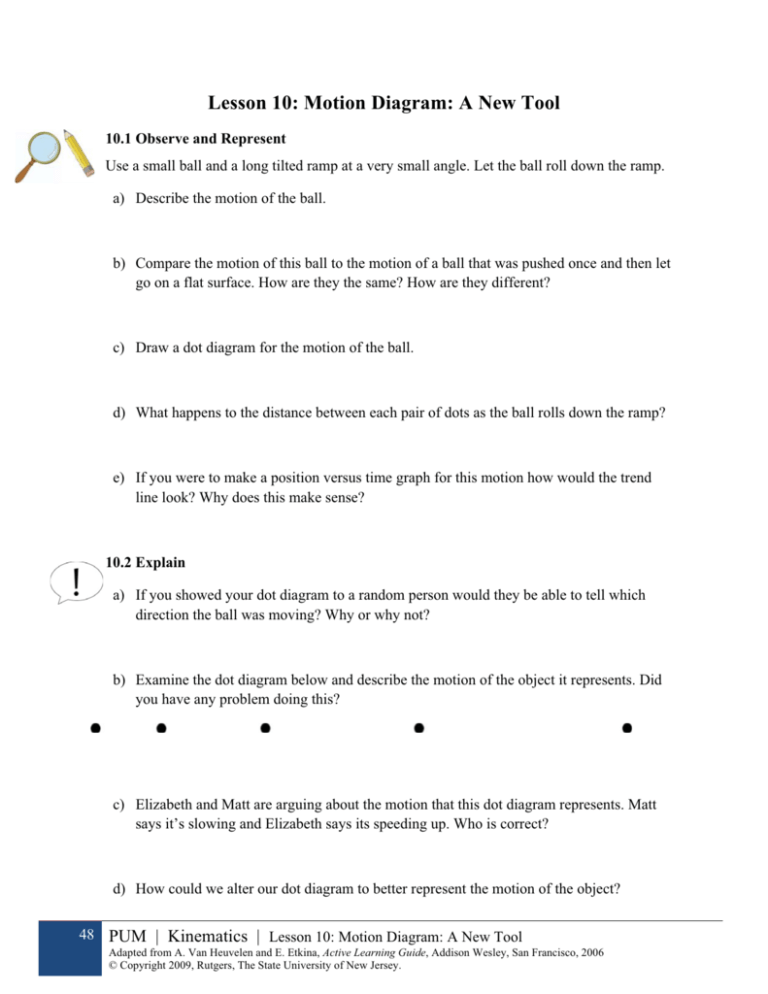Lesson 10: Motion Diagram: A New Tool
advertisement

Lesson 10: Motion Diagram: A New Tool 10.1 Observe and Represent Use a small ball and a long tilted ramp at a very small angle. Let the ball roll down the ramp. a) Describe the motion of the ball. b) Compare the motion of this ball to the motion of a ball that was pushed once and then let go on a flat surface. How are they the same? How are they different? c) Draw a dot diagram for the motion of the ball. d) What happens to the distance between each pair of dots as the ball rolls down the ramp? e) If you were to make a position versus time graph for this motion how would the trend line look? Why does this make sense? 10.2 Explain a) If you showed your dot diagram to a random person would they be able to tell which direction the ball was moving? Why or why not? b) Examine the dot diagram below and describe the motion of the object it represents. Did you have any problem doing this? c) Elizabeth and Matt are arguing about the motion that this dot diagram represents. Matt says it’s slowing and Elizabeth says its speeding up. Who is correct? d) How could we alter our dot diagram to better represent the motion of the object? 48 PUM | Kinematics | Lesson 10: Motion Diagram: A New Tool Adapted from A. Van Heuvelen and E. Etkina, Active Learning Guide, Addison Wesley, San Francisco, 2006 © Copyright 2009, Rutgers, The State University of New Jersey. 10.3 Represent and Reason You decide to “borrow” your parent’s car and roll it down a hill so that it moves faster and faster. A friend sitting in the car drops beanbags out the window each second. The pattern of the beanbags looks similar to the dot diagram of the ball rolling down the tilted ramp from the previous activity (the dot pictures look the same). a) Draw a dot diagram that shows the velocity during each time interval, direction of motion, and a directional axis. Need Some Help? What you need to draw is something physicists call, a motion diagram. It is a sophisticated replacement for a dot diagram that conveys more information about a situation. If you are new to this representation, you may want to list or label the important features so that you are sure to include these when you draw one for yourself. Example: - + 0 b) What does the length of the arrow tell you about the motion of the object? c) What two ways is direction indicated on the representation? Why are both necessary? d) What does the length of each arrow tell you about the motion of the car at a particular dot or position? e) What does the length of each arrow tell you about the motion of the ball at a particular time? f) With a classmate, act out the motion represented in the motion diagram. 10.4 Represent The multiple-exposure picture on the left shows a ball’s motion. The images of the exposure are ¼ of a second apart. a) Describe the motion of the ball. Is it falling or was it thrown upward? b) Create a motion diagrams for the two different possibilities PUM | Kinematics | Lesson 10: Motion Diagram: A New Tool 49 Adapted from A. Van Heuvelen and E. Etkina, Active Learning Guide, Addison Wesley, San Francisco, 2006 © Copyright 2008, Rutgers, The State University of New Jersey. 10.5 Represent Your friend is at the top of a hill on a sled. He is given a very small nudge to get him moving down the hill. Create four different representations for this motion (pictures, graphs, tables, and motion diagrams) Homework 10.6 Represent and Reason a) Describe the motion of the motorcycle in the horizontal direction and vertical direction. b) What major assumption do you have to make in order to complete this activity? c) Represent the horizontal motion of the motorcycle with a motion diagram on the edge of the picture. d) Represent the vertical motion of the motorcycle with a motion diagram on the edge of the picture. 50 PUM | Kinematics | Lesson 10: Motion Diagram: A New Tool Adapted from A. Van Heuvelen and E. Etkina, Active Learning Guide, Addison Wesley, San Francisco, 2006 © Copyright 2009, Rutgers, The State University of New Jersey. e) Create a motion diagram to represent the moon’s motion. f) What additional assumption did you have to make for the moon that you did not have to make for the motorcyclist? g) What conclusion might we make about the motion of the moon? h) What is the benefit of having / making many different representations for the same situation? PUM | Kinematics | Lesson 10: Motion Diagram: A New Tool 51 Adapted from A. Van Heuvelen and E. Etkina, Active Learning Guide, Addison Wesley, San Francisco, 2006 © Copyright 2008, Rutgers, The State University of New Jersey.








